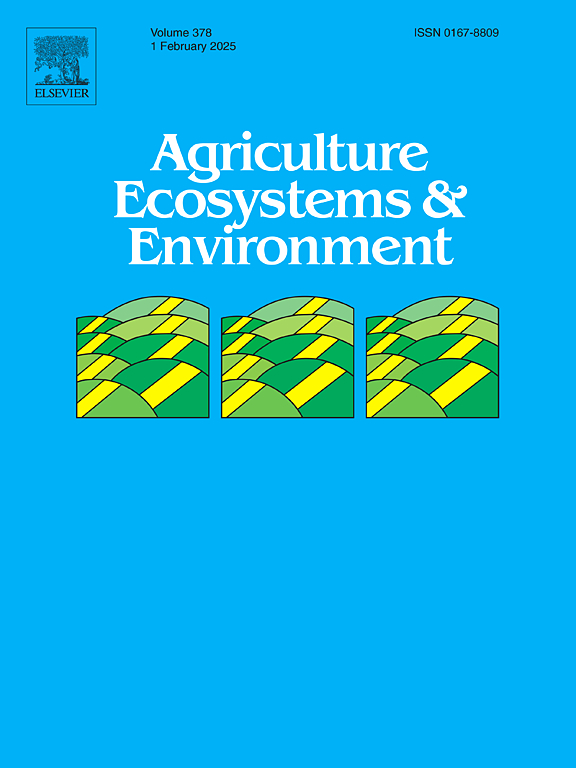在华北平原通过保护性耕作和豆科轮作相结合的方式提高土壤生态系统的多功能性
IF 6
1区 农林科学
Q1 AGRICULTURE, MULTIDISCIPLINARY
引用次数: 0
摘要
基于保护性耕作(CT)和作物轮作原则的保护性农业(CA)已被采纳为应对全球气候变化的一种解决方案。然而,这些原则之间的相互作用及其对土壤功能和作物生产力的累积效应尚未得到充分了解。在此,我们进行了一项为期 4 年的试验,以评估 CA 对华北平原土壤生态系统多功能性(EMF)的影响。结果表明,与传统农业(小麦和玉米轮作系统下的旋耕)相比,CA 对土壤生态系统多功能性的改善高达 532%。与玉米-小麦-玉米-小麦(MWMW)相比,在豆科轮作(LBCR)下,土壤有机碳(SOC)储存量增加了 12.3%,土壤碳氮比(C:N)降低了 8.3%,土壤酶活性指数(SEI)提高了 68.3%,可利用磷(AP)增加了 59.7%。与旋耕(RT)相比,CT 的原理改善了土壤物理结构,提高了土壤团聚稳定性达 38.1%。虽然旋耕技术对作物产量的益处并不总是显而易见,但在 LBCR 与旋耕技术相结合的情况下,旋耕技术对作物产量产生了积极的相互作用。例如,大豆-小麦-大豆-小麦(SWSW)轮作的产量比 CT 下的 MWMW 轮作高 40.8%。总体而言,CT 在改善土壤结构方面的益处,加上 LBCR 中作物残留物多样性的增加、土壤养分化学计量比的调整和土壤酶活性的增强,使得 CA 下的 SOC 固存、作物产量和 EMF 均有所提高。CA 原理之间的良性互动表明,CA 能够增强生态系统的多功能性。因此,建议在 CA 中结合 CT 和 LBCR,以维持 NCP 和其他条件类似地区的生产力。本文章由计算机程序翻译,如有差异,请以英文原文为准。
Enhancing soil ecosystem multifunctionality through combined conservation tillage and legume-based crop rotation in the North China Plain
Conservation agriculture (CA), based on principles of conservation tillage (CT) and crop rotations, has been adopted as a solution to global climate change. However, interactions between these principles and their cumulative effects on soil functions and crop productivity are not yet fully understood. Herein, a 4-year filed experiment was conducted to assess the impact of CA on soil ecosystem multifunctionality (EMF) in the North China Plain (NCP). The results showed that CA improved EMF by up to 532 % compared to traditional agriculture (rotary tillage under wheat and maize rotation system). This enhancement is mainly driven by a 12.3 % increase in soil organic carbon (SOC) storage, an 8.3 % reduction in soil carbon to nitrogen ratio (C: N), a 68.3 % boost in soil enzyme activities index (SEI), and a 59.7 % increase in available phosphorus (AP) under legume-based crop rotations (LBCR) compared to maize-wheat-maize-wheat (MWMW). The principle of CT improved soil physical structure, enhancing soil aggregate stability by up to 38.1 % compared to rotary tillage (RT). Although, the benefits of CT on crop yield were not always observed, positive interactions on crop yield occurred under LBCR combined with CT. For instance, the soybean-wheat-soybean-wheat (SWSW) rotation produced 40.8 % higher yields than the MWMW rotation under CT. Overall, benefits of CT in improving soil structure, along with the increased diversity crop residues, adjustments in soil nutrient stoichiometric ratios, and enhanced soil enzyme activity under LBCR, led to improved SOC sequestration, crop yield and EMF under CA. The positive interactions between the principles of CA demonstrate its ability to enhance ecosystem multifunctionality. As a result, the combination of CT and LBCR within CA is recommended to sustain the productivity in NCP and other regions with similar conditions.
求助全文
通过发布文献求助,成功后即可免费获取论文全文。
去求助
来源期刊

Agriculture, Ecosystems & Environment
环境科学-环境科学
CiteScore
11.70
自引率
9.10%
发文量
392
审稿时长
26 days
期刊介绍:
Agriculture, Ecosystems and Environment publishes scientific articles dealing with the interface between agroecosystems and the natural environment, specifically how agriculture influences the environment and how changes in that environment impact agroecosystems. Preference is given to papers from experimental and observational research at the field, system or landscape level, from studies that enhance our understanding of processes using data-based biophysical modelling, and papers that bridge scientific disciplines and integrate knowledge. All papers should be placed in an international or wide comparative context.
 求助内容:
求助内容: 应助结果提醒方式:
应助结果提醒方式:


